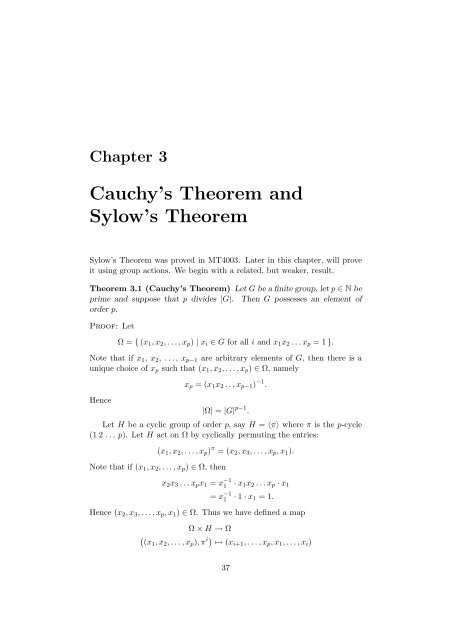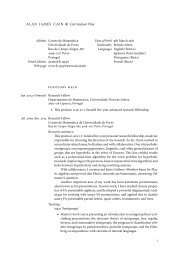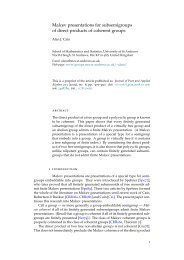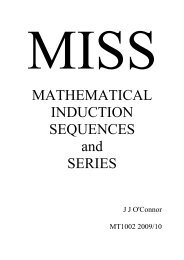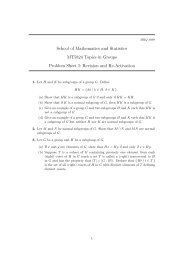Cauchy's Theorem and Sylow's Theorem
Cauchy's Theorem and Sylow's Theorem
Cauchy's Theorem and Sylow's Theorem
- No tags were found...
Create successful ePaper yourself
Turn your PDF publications into a flip-book with our unique Google optimized e-Paper software.
Chapter 3Cauchy’s <strong>Theorem</strong> <strong>and</strong>Sylow’s <strong>Theorem</strong>Sylow’s <strong>Theorem</strong> was proved in MT4003. Later in this chapter, will proveit using group actions. We begin with a related, but weaker, result.<strong>Theorem</strong> 3.1 (Cauchy’s <strong>Theorem</strong>) Let G be a finite group, let p ∈ N beprime <strong>and</strong> suppose that p divides |G|. Then G possesses an element oforder p.Proof: LetΩ={ (x 1 ,x 2 ,...,x p ) | x i ∈ G for all i <strong>and</strong> x 1 x 2 ...x p =1}.Note that if x 1 , x 2 ,...,x p−1 are arbitrary elements of G, thenthereisaunique choice of x p such that (x 1 ,x 2 ,...,x p ) ∈ Ω, namelyHencex p =(x 1 x 2 ...x p−1 ) −1 .|Ω| = |G| p−1 .Let H be a cyclic group of order p, sayH = 〈π〉 where π is the p-cycle(1 2 ... p). Let H act on Ω by cyclically permuting the entries:(x 1 ,x 2 ,...,x p ) π =(x 2 ,x 3 ,...,x p ,x 1 ).Note that if (x 1 ,x 2 ,...,x p ) ∈ Ω, thenx 2 x 3 ...x p x 1 = x −11 · x 1 x 2 ...x p · x 1= x −11 · 1 · x 1 =1.Hence (x 2 ,x 3 ,...,x p ,x 1 ) ∈ Ω. Thus we have defined a mapΩ × H → Ω((x1 ,x 2 ,...,x p ),π i) ↦→ (x i+1 ,...,x p ,x 1 ,...,x i )37
<strong>Theorem</strong> 3.4 (Sylow’s <strong>Theorem</strong>) Let p be a prime number, <strong>and</strong> let G beafinitegroupoforderdivisiblebyp. Write |G| = p n m where p does notdivide m. Then(i) G has a Sylow p-subgroup;(ii) any two Sylow p-subgroups are conjugate in G;(iii) the number of Sylow p-subgroups of G is congruent to 1(modp) <strong>and</strong>divides m;(iv) any p-subgroup of G is contained in a Sylow p-subgroup.Before proving the theorem, let’s see why it’s so important. Part (i)guarantees the existence of a subgroup within a finite group. This is usefulsince the best result we had previously was a theorem that could only be usedfor non-existence (Lagrange’s <strong>Theorem</strong>). Once we have a subgroup, then wecan act on its cosets <strong>and</strong> use the theory of group actions to study the group.Part (ii) tells us that these subgroups occur in a very restricted manner.Once we have a single Sylow p-subgroup P ,thenobviouslyeveryconjugateof P will also be a Sylow p-subgroup (since they all have the same order).This second part of the theorem guarantees that all of the Sylow p-subgroupsof the group arise in this way <strong>and</strong> so once we have one Sylow p-subgroup,we know how to find all of the others. Part (iii) provides useful numericrestrictions upon how many Sylow subgroups occur. Finally, part (iv) tellsus something stronger than Lagrange’s <strong>Theorem</strong> does about the p-subgroupsof G. Lagrange’s <strong>Theorem</strong> tells us that Sylow p-subgroups are the largestp-subgroups of G in terms of subgroup order. Thefinalpartofthetheoremtells us they are also maximal in terms of containment. Specifically, if wewere to draw a diagram of the subgroups of G as suggested in Chapter 1,then the p-subgroups of G all occur as vertices below the Sylow p-subgroupsin the diagram.Proof: (i) Omitted: see Problem Sheet III.(ii)–(iv): Let P be a Sylow p-subgroup of G (which exists since we areassuming part (i) has been. Let Σ be the set of all conjugates of P :Σ={ P g | g ∈ G }.Conjugation maps subgroups to subgroups, <strong>and</strong> preserves element orders.Hence Σ consists of some of the Sylow p-subgroups of G. We must showthat |Σ| ≡1(modp), that Σ consists of all the Sylow p-subgroups of G <strong>and</strong>that every p-subgroup of G is contained in some member of Σ.First let P act by conjugation on Σ:Σ × P → Σ(Q, x) ↦→ Q x = x −1 Qx.39
Since P is a p-group, we may apply Lemma 2.39:|Σ| ≡|Fix P (Σ)|(mod p).Certainly P is fixed in this action: P g = P for all g ∈ P . Suppose thatQ ∈ Fix P (Σ). This means thatQ g = Q for all g ∈ P ;that is, P N G (Q). On the other h<strong>and</strong>, Q N G (Q), so we may applyLemma 1.23(ii) to see that PQis a subgroup of N G (Q), <strong>and</strong> hence a subgroupof G. Lemma1.23(iv)tellsusthat|PQ| =|P |·|Q||P ∩ Q| ,so PQ is a p-subgroup of G. Ontheotherh<strong>and</strong>,P PQ <strong>and</strong> Q PQ,soas both P <strong>and</strong> Q are Sylow p-subgroups of G (that is, p-subgroups of G oflargest possible order),Q = PQ = P.HencesoFix P (Σ) = {P },|Σ| ≡|Fix P (Σ)| ≡1(mod p).Now let H be any p-subgroup of G. LetH act on the set Σ by conjugation:By Lemma 2.39,Σ × H → Σ(Q, g) ↦→ Q g .|Fix H (Σ)| ≡|Σ| ≡1(mod p).Hence there exists at least one member of Σ, say Q, fixedbyH:Q g = Q for all g ∈ H.Therefore H N G (Q). Since Q N G (Q), we see that HQ is a subgroupof N G (Q), <strong>and</strong> hence of G, oforder|HQ| = |H|·|Q||H ∩ Q| .Thus HQ is a p-subgroup of G containing the Sylow p-subgroup Q. Thisforces HQ = Q, soH HQ = Q.40
Thus, every p-subgroup of G is contained in a conjugate of our original Sylowp-subgroup P <strong>and</strong> these certainly are among the Sylow p-subgroups of G.Consequently part (iv) of the Sylow’s <strong>Theorem</strong> is now established.Part (ii) now follows quickly from what we have established. If R is anySylow p-subgroup of G, takingH = R in the above argument shows thatR Q for some Q ∈ Σ. But R <strong>and</strong> Q are both Sylow p-subgroups of G,so have the same order, so R = Q ∈ Σ. In conclusion, Σ consists of allthe Sylow p-subgroups of G, <strong>and</strong>thereforetheyareallconjugate,<strong>and</strong>thenumber of Sylow p-subgroups is congruent to 1 (mod p).To complete the proof of part (iii), recall that the number of conjugatesof a subgroup equals the index of its normaliser:Now P N G (P ) G, so|Σ| = |G :N G (P )|.m = |G : P | = |G :N G (P )|·|N G (P ):P |.Hence |Σ| = |G :N G (P )| divides m.□Sylow’s <strong>Theorem</strong> turns out to be a very powerful tool in determining thestructure of a finite group. It is useful in finding subgroups <strong>and</strong> even normalsubgroups. In many ways it was the first result which enabled the searchfor finite simple groups to begin.Definition 3.5 Anon-trivialgroupG is simple if the only normal subgroupsit has are 1 <strong>and</strong> G.Example 3.6 Let G be a group of prime order p. Then,sincetheorderofany subgroup must divide p, theonlysubgroupsofG are the trivial subgroup<strong>and</strong> G itself. Thus G is simple. Furthermore, let x be a nontrivial elementof G. Then〈x〉 ≠ 1, so〈x〉 = G. ThereforeG is cyclic.The idea is that if G is not simple then it has a non-trivial proper normalsubgroup N <strong>and</strong> we can break it down into two smaller groups N <strong>and</strong> G/Nwhich are hopefully easier to h<strong>and</strong>le than G. Later in the course we shallsee that in some sense there is a unique factorisation of groups into simplefactors. When G is simple this process yields nothing new: one of thesegroups is trivial <strong>and</strong> the other is just a copy of G. If G is not simple, thenputting N <strong>and</strong> G/N back together again afterwards is far from straightforward.We shall meet some ways of putting groups back together, but thisis very much an open research topic.Example 3.7 Let G be a group of order 40. Then G is not simple, <strong>and</strong>G has a normal Sylow 5-subgroup.41
Proof: |G| =40=2 3 · 5. By Sylow’s <strong>Theorem</strong>, G possesses at least oneSylow 5-subgroup F ,<strong>and</strong>thenumberofSylow5-subgroupsisn 5 ,wheren 5 ≡ 1 (mod 5) <strong>and</strong> n 5 | 8.This forces n 5 =1,soF is the unique Sylow 5-subgroup of G. HenceF g = F for all g ∈ G,so F G.□Example 3.8 Let G be a group of order 56. Then G is not simple, <strong>and</strong>either G has a normal Sylow 2-subgroup or it has a normal Sylow 7-subgroup.Proof: |G| =56=2 3 · 7. Let n 7 be the number of Sylow 7-subgroups of G.Thenn 7 ≡ 1 (mod 7) <strong>and</strong> n 7 | 8.Hence n 7 =1or8. Ifn 7 =1,thentheuniqueSylow7-subgroupofG isnormal in G.Suppose n 7 =8. ConsidertwodistinctSylow7-subgroupsS 1 <strong>and</strong> S 2of G. Then |S 1 | = |S 2 | =7. TheintersectionS 1 ∩ S 2 is a proper subgroupof S 1 ,so|S 1 ∩ S 2 | divides 7, by Lagrange’s <strong>Theorem</strong>. Hence S 1 ∩ S 2 = 1.It follows that each Sylow 7-subgroup of G contains 6 non-identity elements(all of order 7) <strong>and</strong> these are contained in no other Sylow 7-subgroup. Hencethe Sylow 7-subgroups account for8 × 6=48elementsoforder7.So G only contains 8 elements which do not have order 7. The Sylow 2-subgroups of G have order 8, so there can therefore be only one of them(consisting of these remaining 8 elements), which must be normal in G. □Example 3.9 Let G be a group of order 36. Then G is not simple.Proof: Let H be a Sylow 3-subgroup of G. Then |G : H| =4. LetG acton the set of right cosets of H by right multiplication:(Hx,g) ↦→ Hxg(see Example 2.34). A group action determines a permutation representation<strong>and</strong> consequently we obtain a homomorphism ρ: G → S 4 .Since|G| =36|S 4 | =24,wecertainlyhavekerρ ≠ 1. Ontheotherh<strong>and</strong>,<strong>Theorem</strong>2.35(i)tells us that ker ρ ≠ G (because Gρ ≠ 1). It follows that ker ρ is a non-trivialproper normal subgroup of G <strong>and</strong> hence G is not simple.□Proposition 3.10 Let p <strong>and</strong> q be distinct primes <strong>and</strong> let G be a finitegroup of order p 2 q.Thenoneofthefollowingholds:42
(i) p>q<strong>and</strong> G has a normal Sylow p-subgroup;(ii) q>p<strong>and</strong> G has a normal Sylow q-subgroup;(iii) p =2, q =3, G ∼ = A 4 <strong>and</strong> G has a normal Sylow 2-subgroup.Proof: (i) Suppose p>q.Letn p denote the number of Sylow p-subgroupsof G. Thenn p ≡ 1 (mod p) <strong>and</strong> n p | q.The latter forces n p =1orq. But1


